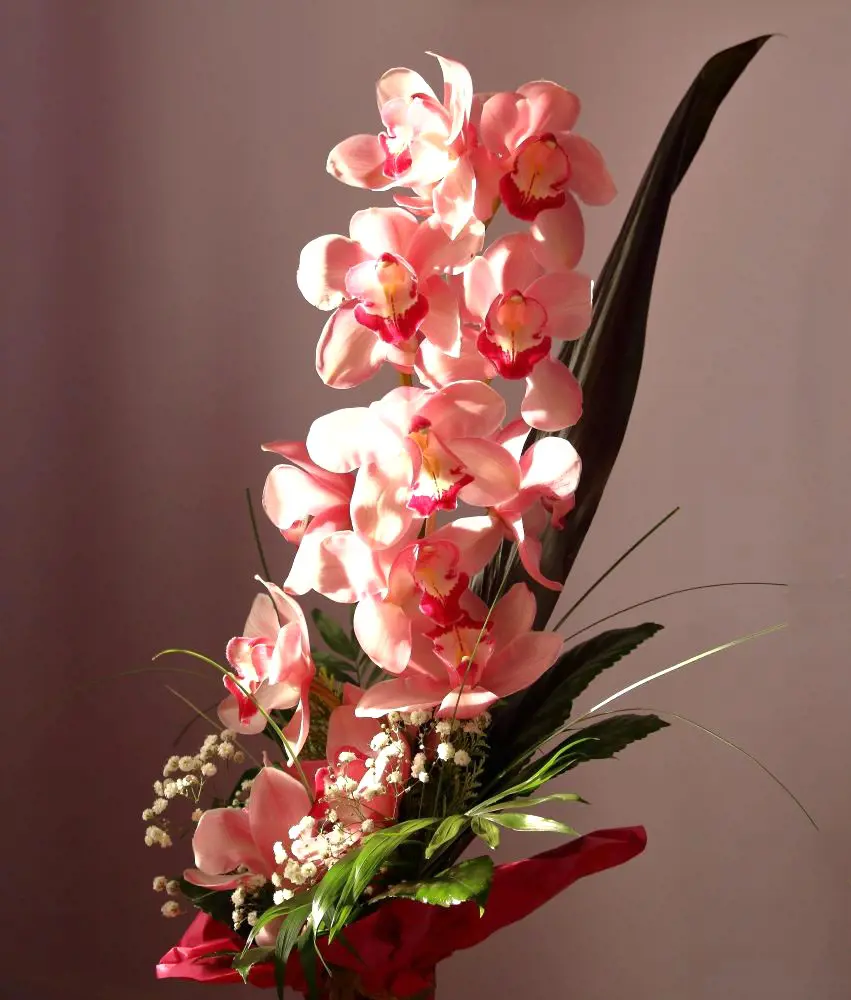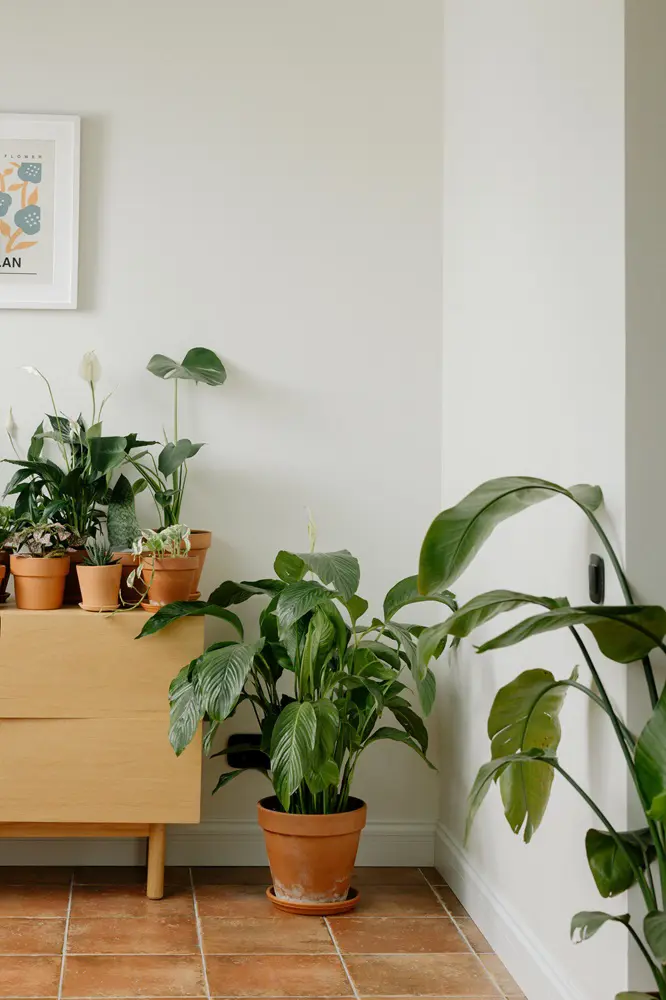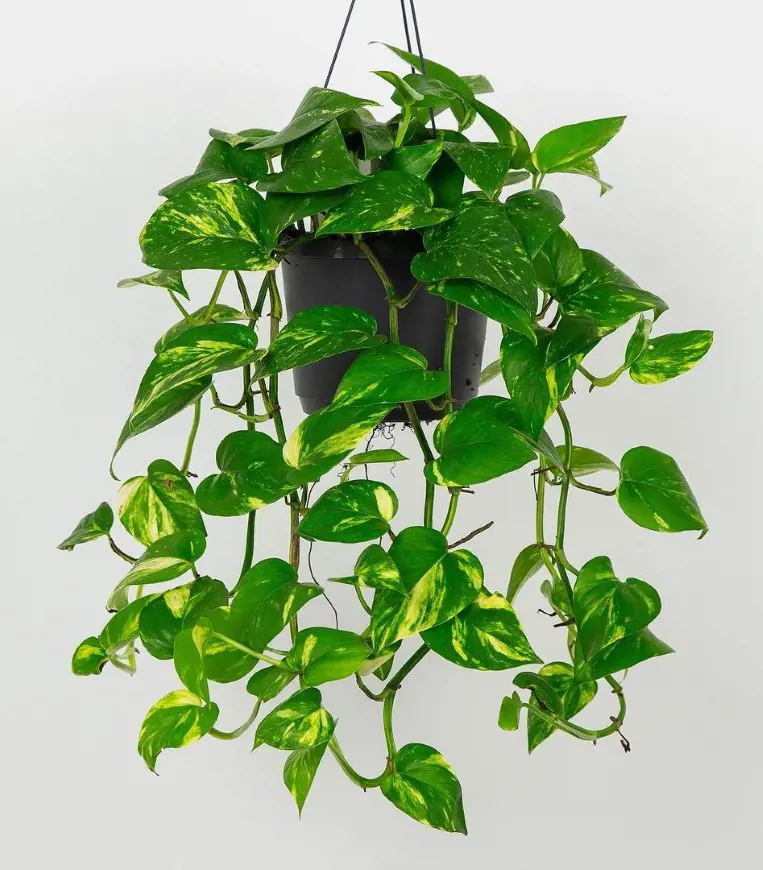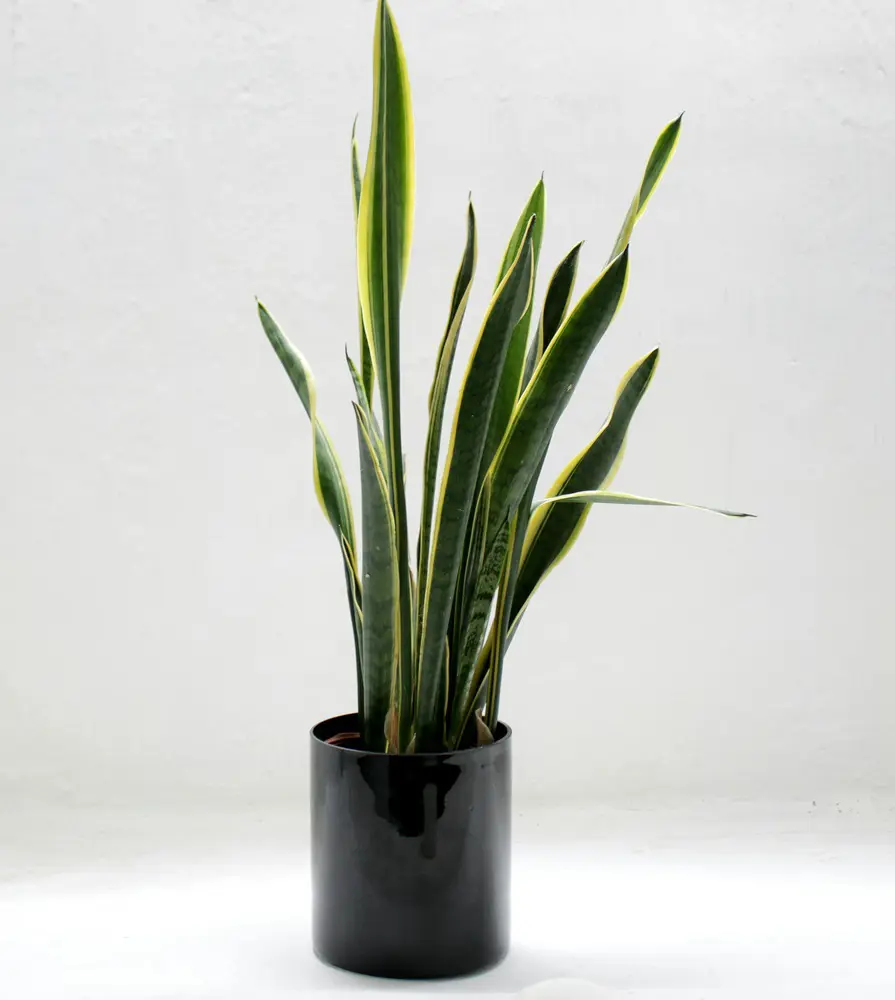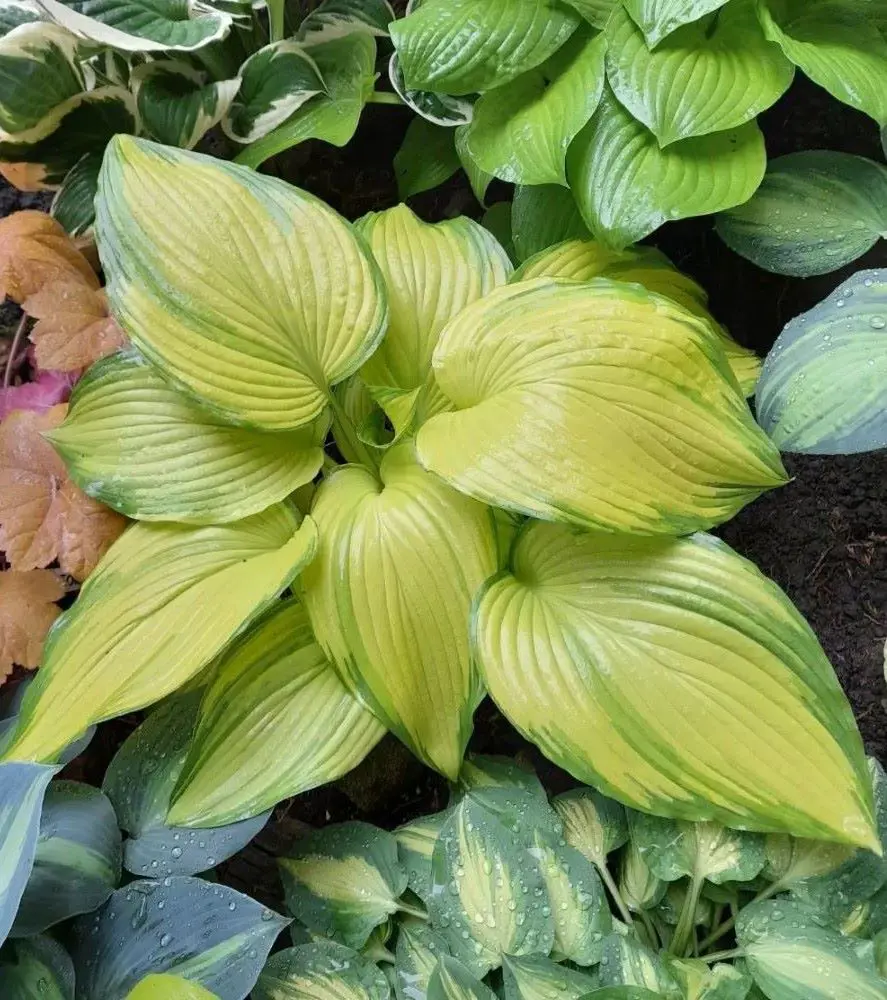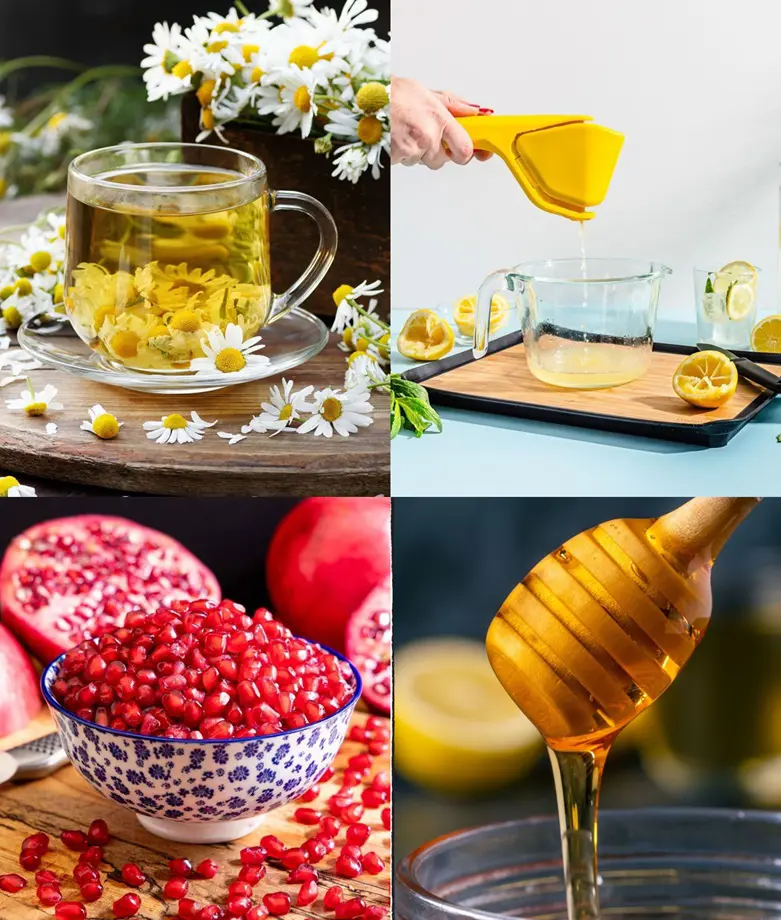Orchid Leaves Turning Yellow: Reasons & How To Fix It
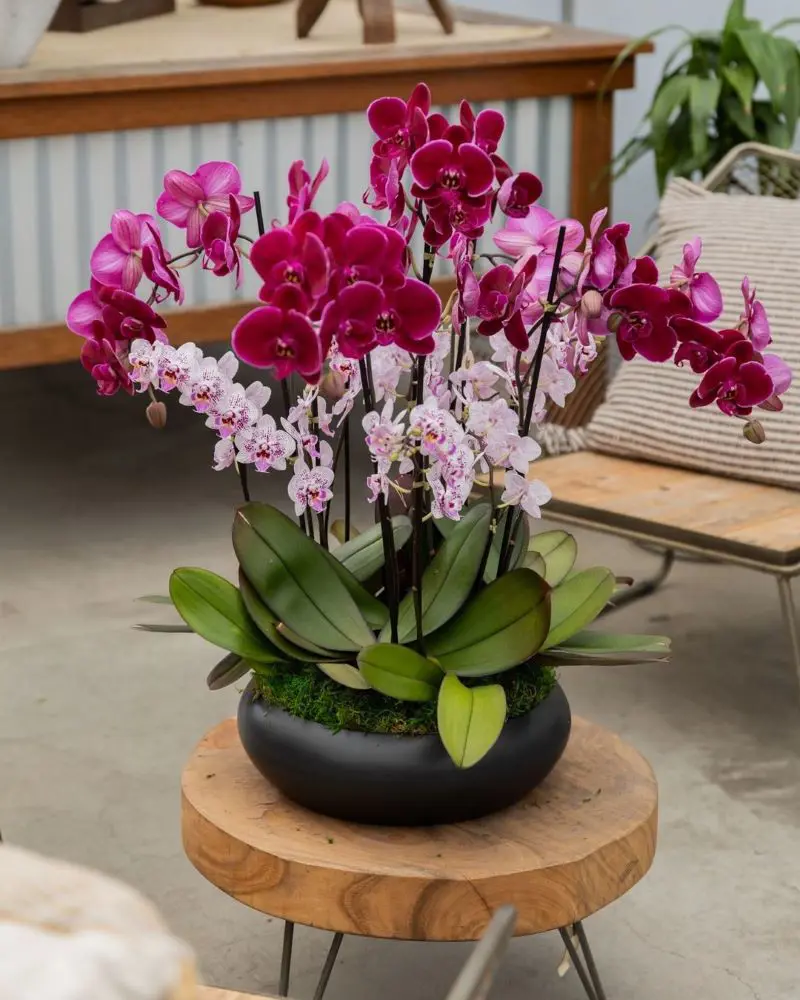
This post may contain affiliate links. If you make a purchase through links on our site, we may earn a commission.
Orchids are perennial herbaceous plants known for their distinctive flowers and fascinating growth patterns. These herbs flourish best in warm, humid environments characterized by moderate temperatures, high levels of indirect light, and consistent moisture.
The vast majority of these plants are native to the tropics, including rainforests, mountainsides, and other moist habitats. Despite meticulous care, orchids may still exhibit signs of distress, such as their leaves turning yellow.
This phenomenon can occur due to several factors like improper watering practices, insufficient sunlight exposure, extreme temperature fluctuations, and nutrient deficiencies. Thus, It's essential to identify the root cause promptly to ensure the health and longevity of your beloved orchid collection.
Orchid Plant Overview
| Scientific Name | Orchidaceae |
| Common Name | Orchid, boat orchid, moth orchid |
| Plant Type | Perennial |
| Size | 1 to 3 feet tall |
| Soil Type | Well-drained |
| Soil pH | Acidic |
| Sun Exposure | Partial shade |
| Bloom Time | Depends on the species |
| Flower Color | Pink, purple, white, orange, red, yellow |
| Zones | 5–11 (USDA) |
Understanding The Causes
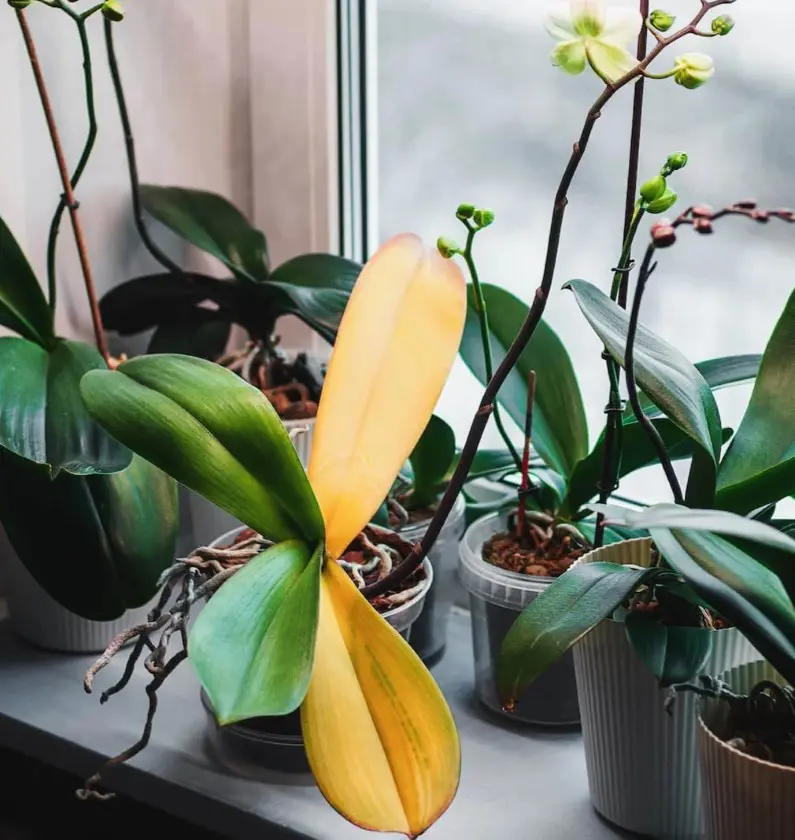
Orchid leaves turning yellow may not always indicate the presence of a disease. Sometimes, it's simply a natural aspect of the plant's life cycle or a response to changes in its environment.
However, If the yellowing continues and worsens over time, it could signal a more serious issue. This might be related to factors such as over and under watering, inadequate light exposure, or even nutrient deficiencies.
Watering Issues
Overwatering is the most common reason for yellowing their leaves. Too much water can lead to root rot, preventing the plant from absorbing nutrients and moisture properly. Consequently, the leaves will start to turn yellow and eventually fall off.
While less common than overwatering, underwatering can also cause yellowing leaves. When an orchid doesn't receive enough water, it can dry out, causing its leaves to wilt and turn yellow.
Lighting Problems
If orchids don't receive enough sunlight, they can't produce sufficient chlorophyll. This leads to a decrease in the green color of their leaves and eventual yellowing.
On the other hand, if they are placed in direct sunlight, the leaves will become pale and start to fall out due to sunburn caused by excessive exposure to light.
Nutritional Deficiencies
Orchids require essential nutrients such as nitrogen, phosphorus, and potassium to grow healthily. In case of deficiency in any of these nutrients, their leaves may begin to turn yellow. A lack of nitrogen typically manifests as discoloration starting from the tips of the leaves.
Similarly, phosphorus deficiency may cause leaves to appear dark green or purple underneath, while insufficient potassium levels may appear as yellowing along the edges and between the veins of the leaves.
Salts Buildup
If you use tap water to water your orchid, the minerals and salts in the water can build up in the potting medium over time. This can damage the roots and lead to yellowing leaves.
Other Potential Causes
Orchid leaves turning yellow is not solely limited to issues related to light, nutrition, and water. Deficiencies in these areas can certainly contribute to leaf discoloration; however, several other potential problems can cause these issues. Some of them include:
- Poor drainage in the container.
- Infestations by pests and other fungal diseases.
- Extreme fluctuation in temperature.
- Sudden shifts in humidity, airflow, and location.
- Natural aging process.
- Exposure to chemicals like pesticides and fungicides.
- Dust accumulation on the leaves.
Identifying The Actual Cause
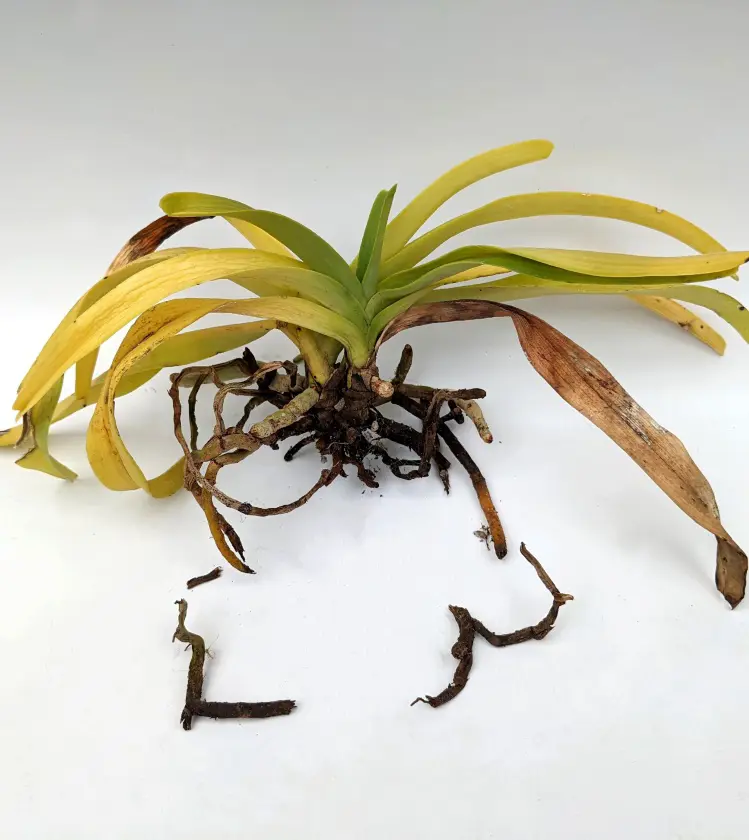
Once your orchid leaves begin to yellow, they typically exhibit symptoms such as a fading of their green color. This fading or discoloration starts from the edges or tips and spreads inward. In some cases, the yellowing may progress to wilting or shriveling of the foliage.
These symptoms often indicate underlying issues such as overwatering, underwatering, nutrient deficiencies, or environmental stressors. This step-by-step guide will help you diagnose the cause of yellowing leaves in orchid plants.
- Inspect the Leaves: Look for any patterns such as whether the yellowing is occurring uniformly across the plant or if it's localized to certain areas. Also, note any other symptoms such as spots, holes, or wilting.
- Examine Soil Moisture: Feel the potting medium by inserting your finger or a pen into the top 1 inch of soil. If it's consistently soggy, overwatering might be the issue. If it's dry and the plant seems thirsty, underwatering could be the cause.
- Assess Light: Evaluate the location of the plant and determine whether it's receiving appropriate light levels throughout the day. Too much direct sunlight can cause burns, which may result in yellowing leaves.
- Evaluate Temperature: Sudden exposure to cold temperatures can cause damage to the leaves of orchid plants. This damage may appear as blackened or browned areas on the leaves. In extreme cases, they may become wilted.
- Check Humidity Levels: Orchids generally prefer high humidity. If the air is too dry, especially in heated indoor environments, the leaves may shrivel.
- Inspect for Pests: Check both sides of the leaves and along the stems for signs of pests, such as aphids, spider mites, or scale insects. Also, look for indications of bacterial infections, such as dark spots and unusual growths.
- Review Fertilization: Examine your fertilization regimen. Over-fertilizing can lead to salt buildup in the growing medium, causing nutrient imbalances. Adjust the nutrition accordingly.
- Consider Repotting: If you have ruled out other causes and suspect root issues like overcrowding, consider repotting your orchid. Inspect the roots for signs of rot, trim away any affected portions, and repot in fresh orchid potting mix.
- Implement Remedial Actions: Based on your observations, take appropriate actions to address the identified issues. This may involve adjusting watering practices, improving lighting conditions, treating pests, and repotting if necessary.
- Monitor Changes: After implementing any adjustments and treatments, monitor your orchid closely for changes. It may take some time for the plant to recover, so continue to provide proper care.
Treatment Options

If addressed promptly, discoloration in leaves is often treatable. As mentioned earlier, the yellowing may result from various factors such as overwatering, inadequate light, nutrient deficiencies, and more. Once you identify the specific cause, you can take appropriate steps to address it and help the orchid recover.
However, in certain instances, treating these issues can be challenging, especially if multiple factors are contributing to the problem. Plus, if the plant is severely stressed and root rot has progressed significantly, it may be more difficult to revive the plant.
Adjust Watering Practices
First, ensure that your orchid's pot has adequate drainage holes to prevent water from pooling at the roots. When watering, always use room-temperature water. If it is rainwater or distilled water, it's even better as orchids are sensitive to chemicals and minerals found in tap water.
When yellow leaves have already occurred, trim away those leaves, and monitor the plant closely. If the leaves have turned yellow due to overwatering, reduce the frequency of watering. If underwatering is the issue, increase the frequency, but still allow the soil to dry out slightly between waterings.
Provide Bright, Indirect Light
Providing bright indirect light can indeed help prevent yellowing leaves on your orchid plant. However, simply adjusting the lighting conditions might not be the only solution if its leaves are already turning yellow. So, make sure your plant is receiving enough light but not direct sunlight, which can burn the leaves.
Bright indirect light typically means placing the orchid in a spot where it receives bright but filtered light throughout the day. If your orchid isn't getting enough light, try moving it closer to the window.
Feed Nutrient-Rich Fertilizer
Select a fertilizer specifically formulated for orchids that contains micronutrients like nitrogen, phosphorus, iron, and calcium. Dilute it according to the manufacturer's instructions, and apply it every 2-4 weeks during the growing season. If you have been doing this regularly but also notice yellowing leaves, then overfertilization could be the reason.
Orchids are sensitive to excess salts and nutrients, which can build up in the growing medium over time and cause root damage. If you suspect overfertilization, it's best to flush the growing medium with plain water to leach out any excess salts before resuming fertilization at a lower concentration.
Other Treatment Methods
After fertilizing, monitor your orchid closely to see how it responds. If the yellowing persists or worsens after fertilization, it may indicate that the issue is not related to nutrient deficiency, and further investigation into other potential causes is necessary.
Therefore, in addition to the common techniques like proper watering, lighting, and fertilizing, there are other ways to cure orchid issues. Some of them are:
- Flush With Water: Every few months, flush the orchid's potting medium with plain water to remove any accumulated salts from fertilizers, which can harm the roots.
- Maintain Consistent Environment: Orchids thrive in stable environmental conditions, so try to maintain a consistent temperature, humidity, and air circulation around the plant.
- Pruning: If the yellowing leaves are old or damaged beyond repair, you can carefully trim them off to encourage new growth.
- Pest Control: If you notice any pests, treat the plant with appropriate insecticidal soap or horticultural oil, following the manufacturer's instructions. For fungal and bacterial infections, remove affected plant parts and apply a fungicide as directed.
- Inspect Orchid Support: The support structure might be causing physical damage to the leaves, stems, or roots of the orchid. This damage can lead to stress and result in yellowing leaves. Ensure that the support structure is not too tight or rough against the plant.
General Care Tips

Caring for orchid plants requires attention to their specific needs, which can vary depending on the type of orchid you have. Understanding their natural habitat and growth habits is key. It ensures providing the right conditions for flourishing orchids, guaranteeing they receive the care customized to their individual requirements. Here are some general tips for orchid care:
Light
Most orchids usually prefer bright, indirect light, which mimics their natural habitat conditions. South or east-facing windows, in particular, are considered ideal. It's important to avoid direct sunlight as it can easily scorch the leaves.
If you notice the leaves turning yellow, it's a sign that your orchid might not be receiving enough light. Conversely, if the leaves appear dark green, it could indicate that the orchid is getting too much light.
Water
Overwatering is the most common mistake orchid owners make. Their roots should dry out slightly between waterings, so always check the soil before watering them. But in terms of watering frequency, the situation depends on several factors, such as the type of orchid, pot size, light, and temperature.
A good rule of thumb is to water once a week, adjusting based on your specific plant and growing conditions as necessary. Use lukewarm water and soak the pot thoroughly until water runs out of the drainage holes. Never let the plant sit in water.
Temperature
Orchids thrive in warm temperatures ranging from 15-27°C, so it's important to shield them from drafts and sudden temperature fluctuations. Otherwise, their growth and flowering cycles will be disrupted, leading to stress and potentially causing damage to the plant.
Humidity
These plants need warm conditions with humidity levels higher than 50%. You can increase humidity by grouping them with other plants such as ferns or bromeliads. Alternatively, you can place them on a tray filled with water and pebbles, or use a humidifier.
Soil
Orchids are typically not grown in soil; instead, they thrive in well-draining potting mediums such as bark chips, sphagnum moss, or specialized orchid mixes. These mediums provide aeration to the roots, preventing them from becoming waterlogged and prone to rot.
The mix should be loose and airy, allowing water to drain freely while still retaining some moisture. Depending on the orchid species and its specific requirements, the potting medium may need some adjustment. Regular repotting every couple of years helps refresh the potting medium and maintain its health.
Pruning
Orchids often have aerial roots that extend outside of the potting medium. These roots are crucial for nutrient uptake and anchoring the plant.
However, if you notice any roots that are mushy, brown, or rotting, they should be trimmed away to prevent the spread of disease. Use sterile scissors to carefully remove damaged roots, making clean cuts to minimize stress on the plant.
When To Seek Help

If only one or two leaves are yellowing at the base of the plant, it's likely nothing to worry about. You can simply remove the yellow leaves. But if you are not sure what's causing your orchid leaves to turn yellow, it's always best to consult with a professional orchid grower or garden center. They can help you diagnose the problem and recommend the best course of treatment.
Here are some situations where seeking expert advice would be beneficial:
- If your orchid's leaves keep changing colors despite adjusting water and light, there may be an ongoing problem.
- Leaves and stems are consistently wilting and drooping.
- Orchid fails to produce flowers despite being in their flowering season and receiving adequate care.
- Unusual spots, lesions, or webs on their leaves and stems.
- Sudden changes in growth patterns like starts exhibiting rapid growth, stunted growth, or abnormal growth patterns.
Conclusion
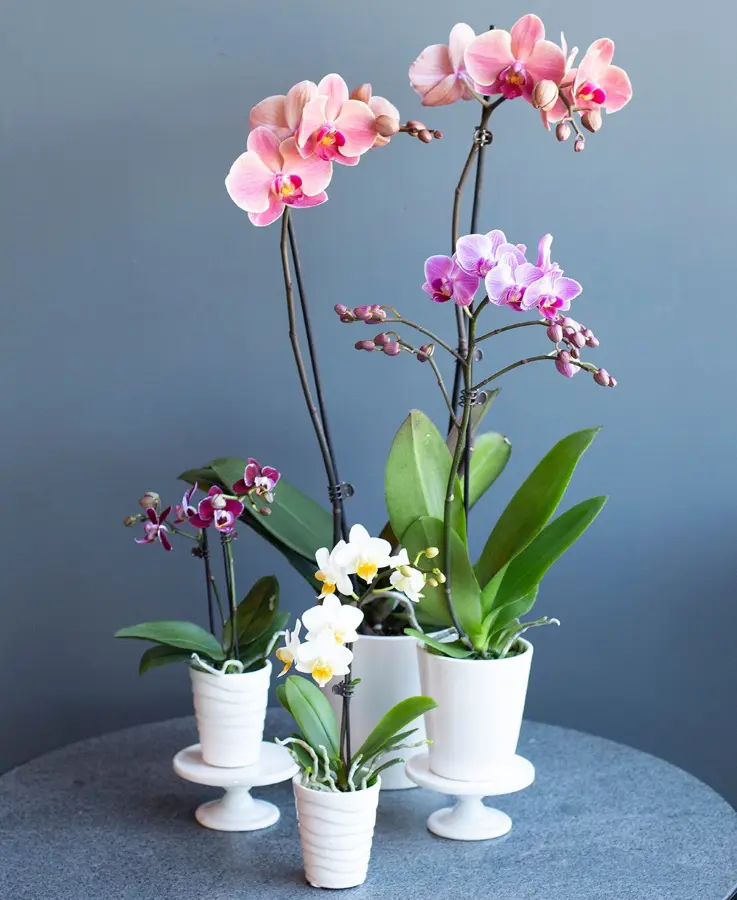
When orchid leaves start turning yellow, several factors could be at play. Overwatering, underwatering, insufficient light exposure, nutrient deficiencies, and other environmental stresses are common causes. Pests like scale insects and mealybugs might feed on the leaves, causing discoloration. Similarly, fungal infections such as root rot can lead to yellowing foliage.
To address the issue, it's crucial to adjust the orchid's care routine accordingly. Check the watering schedule, ensuring the plant isn't sitting in waterlogged soil. Evaluate the light conditions, aiming for bright, indirect light without exposing the orchid to direct sunlight for prolonged periods.
Providing a balanced fertilizer formulated for orchids can help replenish any nutrient deficiencies. In more severe cases, pruning affected leaves and repotting in fresh, well-draining potting mix may be necessary to prevent further damage. If the problem persists despite your efforts, seek professional assistance from an experienced orchid grower or a horticulturist.
Recent posts
Plant Care
Plant Care
How To Take Care Of An Orchid Plant? 11 Tips And Tricks
If you love gorgeous orchids but are worried they're too high-maintenance, don't worry. This guide is like a cheat sheet for orchid newbies. Forget fancy words and confusing schedules — we're talking about how to take care of an orchid pla...
Plant Care
How To Grow and Care For Peace Lily Plant
The Peace Lily is an indoor plant that is most valued for its beautiful and shiny green leaves as well as the white blooms. Hard and tolerant, it’s naturally a low-maintenance addition to your plant collection. If you are confused, let us tell ...
Plant Care
Pothos Plant Care And Growing Guide
Adding a Pothos plant (Devil’s Ivy) to your home benefits the environment and aesthetic of your personal space. It's easy to maintain and is loved for it's ability to enhance indoor air quality by removing toxins like formaldehyde, benzene, and...
Plant Care
Snake Plant Care and Growing Guide
Snake plants require low maintenance, and low light and are almost impossible to kill, making them a perfect plant for beginners and seasoned gardeners. In this guide, we will explore essential care tips and optimal growing conditions for snake plant...
Plant Care
How To Plant, Grow and Care Majesty Palm
The majestic palm, scientifically known as Ravenea rivularis, makes for a stunning indoor tree with its lush and grand fronds. Originating from Madagascar's river banks, this resilient houseplant is cherished not only for its beauty but also for its ...
Plant Care
How To Grow And Care For A Hosta Plant
Hosta plants are widespread perennials, often grown for their beautiful and diverse foliage. They are extremely easy to care for and can thrive in various conditions, particularly shade or semi-shade. These hardy plants can last for many years and re...
